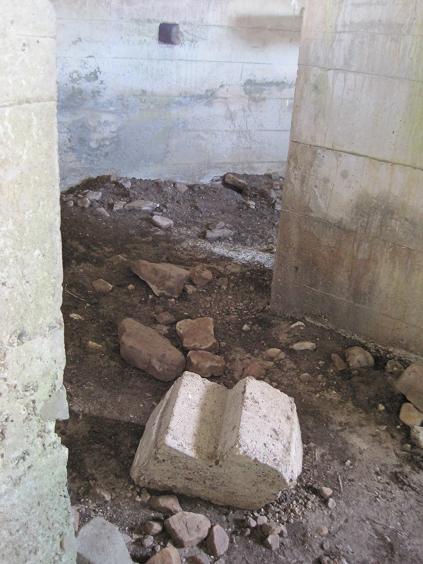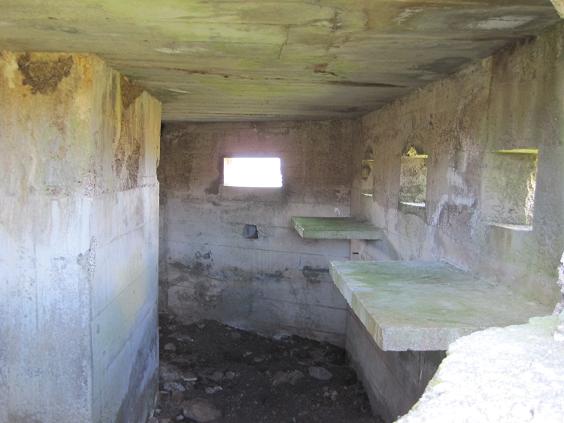OK! Who dunnit????? Stand up that man!
I wandered lonely as a cloud
that wanders over vale and hill.
When all at once I saw a box
that never ever held a pill
Ok that is about as close as I will get to being poet laureate, but I bet she knows swat all about fortifications eh? Ok then, so that makes another one of us.
Anyhow here are a few pics of one of the boxes out in the Northumbrian wastes. Unusual in that it is absolutely peppered (and I mean totally, utterly completely!) with small arms impact marks on one face and the adjoining face has had its embrasure opened up with something slightly more powerful. Given that one of the aperture’s ‘formed’ side block is inside the building I suggest it was put there by the impact of a round(s) or attached explosive on the outside. Reasoning that if a charge had been exploded inside the box then the result would have been very different.
A passing fellow geek (sorry, enthusiast) told me that another box along the ‘stop line’ had received similar treatment; but I didn’t have time to visit that one on this day. What more interested me were the questions when, and from where, did the box receive this treatment? Given that this site is not within any post-war training area that I am aware existed (but always happy to have my records updated if anyone knows different) I submit that the damage was done during the war when it was pretty much certain that the threat of invasion was gone and some unit, of the many different troops who were based in the area during the later stages of the war, decided to use them as target/training practise.

‘The approach up the road opposite the most damaged face’
I am not even slightly familiar with what type of weapon can do what type of damage so anything I suggest is just speculation, and I invite any others to study the photos and speculate for themselves what they think may be the scenario. Where from? Looking out from the box faces for the main of the peppered sides it is difficult to decide just where the offending weapons were sited. What is remaining of the impact marks, now weathered by 60+ Northern winters, suggested to me pretty much a ‘full on’ firing point at 90degrees to the face. Unfortunately that is out in to open space, there being no land on a level opposite. This can be seen from the rear photo of the box.

‘Rear view looking out and down from the box, road just visible’
The only land directly to the front of the face falls away quite steadily; maybe the weapon was on a vehicle on the road? Even then I would have expected to see some suggestion of ‘direction’ upwards in the impact marks. The spalling of the concrete is quite pronounced.

‘Totally pock marked face, compare with the rear ones’
I feel that what may give some credibility to this suggestion is that the lower part of the face has no real comparable damage and this maybe suggests a lower firing point, the undulations of the slope between the road and the box having shielded this part. The shorter face with the broken aperture is more easily deduced as there is high ground immediately opposite here and also the road rises around this side. What caused the larger amount of damage?

‘ Side face with major impact damage, as viewed from the road’
It certainly was something more substantial than small calibre weapons. A number of things spring to my mind such as a bazooka, PIAT, grenades or rounds from a smaller ‘artillery’ weapon.
‘ Slightly closer of the same’
So here is my deduction dear Watson. A tank, of which there were units in the wider vicinity, came up the road, turned the turret towards the first face of the box and gave it right good blasting with its machine gun. It then went further up the hill, round the bend until it came around to a point opposite the shorter side upon which it let off a couple, maybe three rounds with its main weapon. One round hit the top edge of the box and took this off leaving the depression seen and the second, and maybe a third, round made contact with the aperture smashing the formed edge blocks. Sending one of them largely intact back inside the building, along with miscellaneous other bits of largish concrete pieces.

‘ Interior showing side block from aperture blown in’
‘ Interior showing impact damage to gun port edges and wall faces and corners’

Possibly it represents the result of more than one ‘attack’, (nothing like going around for another go!) or maybe more than one tank was involved. I favour this scenario rather than a raid by infantry as I feel the concentration of impact marks suggests something quite intense rather than piecemeal popping off, even over a period of time. Something quite specific and completed at one period in time, thinking that regular persistent use would more likely have resulted in damage being done to more of the faces?
Of course, all this could be complete rubble.
